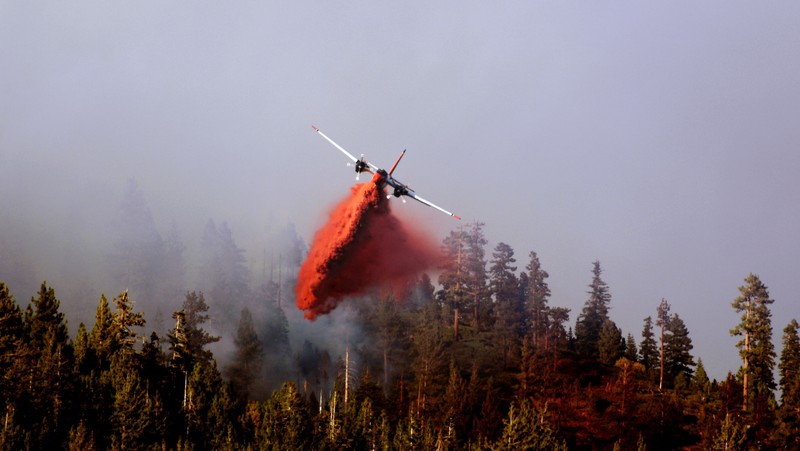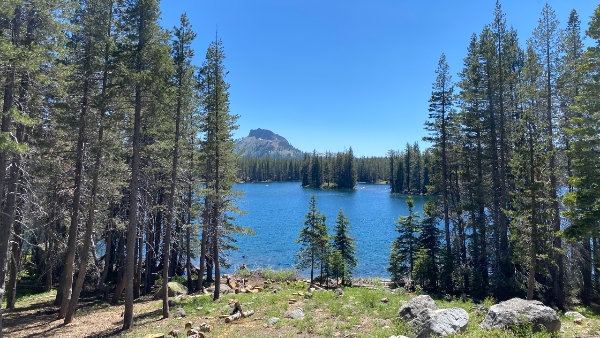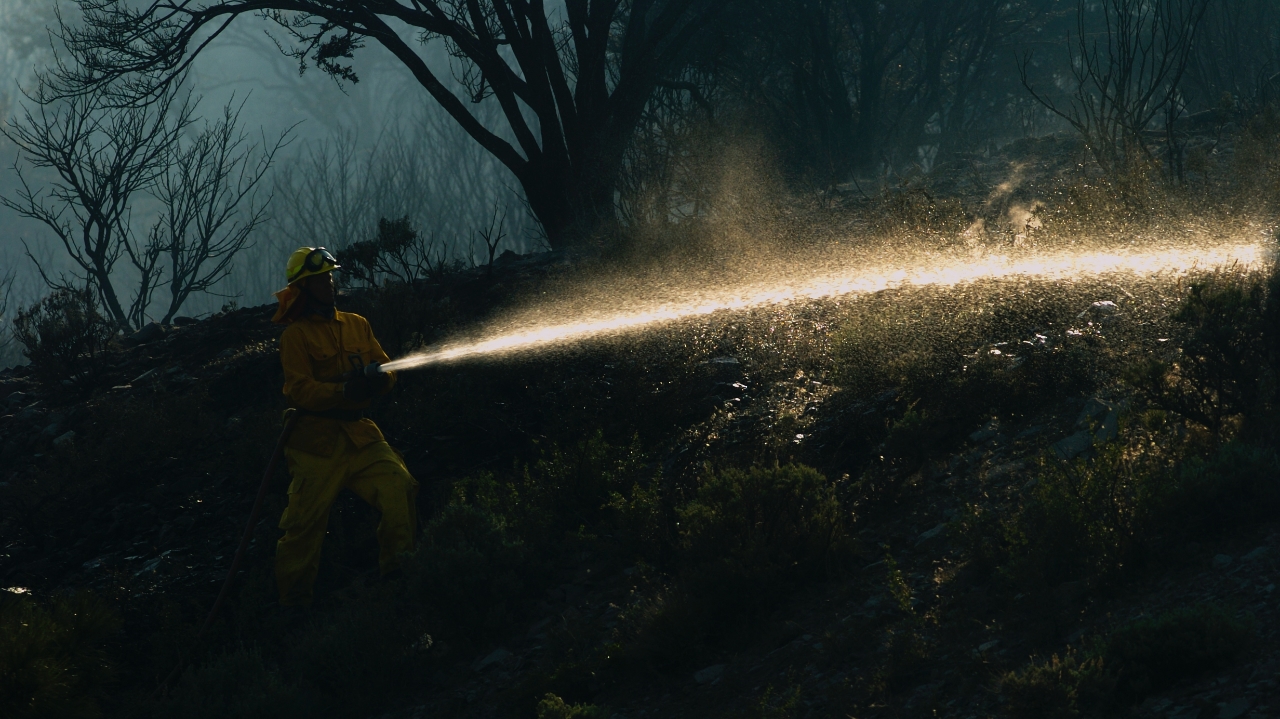The Tahoe Truckee Community Foundation develops partnerships to prepare and respond to emergencies with its COAD (Community Organizations Active in Disaster).

A CalFire tanker aircraft drops a plume of fire retardant on a forest. Court Leve Productions
When a wildfire ignited near Royal Gorge on July 7 in the midst of a crippling heat wave, a local agency that was formed in 2022 by TTCF immediately sprung into action.
The Tahoe Truckee COAD (Community Organizations Active in Disaster) had spent the previous 18 months developing and enhancing partnerships to create a resilient Tahoe Truckee region that is prepared to respond to and recover from disasters. This was achieved through communication, cooperation, coordination, and collaboration with a variety of stakeholders including nonprofit and faith-based organizations, government agencies, and the private sector.
A COAD is a relatively new kind of local entity. As the climate crisis has dramatically increased the frequency of natural disasters, community foundations nationwide are stepping up to lead preparedness efforts. With California experiencing a rash of catastrophic wildfires, along with earthquakes, snow storms and incidents of gun violence, more than 30 community foundations throughout the state have set up COADs and VOADs (Voluntary Organizations Active in Disaster). This movement has found that the most important elements of successful emergency response are communication and coordination. Communities are learning how to coordinate planning prior to a disaster, communicate during a disaster, and help a community recover after a disaster.
During emergencies such as wildfires and snowstorms, misinformation spread accidentally can cause profound harm. Even well-intentioned help that is not appropriate to a specific situation can result in unwanted complications that can hinder an efficient and coordinated response. And the coordination that is crucial during a disaster is a unique challenge in North Tahoe Truckee because while the Town of Truckee is incorporated, the rest of the region is not. The responsibility of crisis response is shared across different jurisdictions and counties. The result is that a person who lives on one side of a street may receive entirely different evacuation information from their neighbor due to county lines.
The Central Players Come Together
In July 2021, North Tahoe was reeling from COVID-19 when the Dixie Fire, Beckwourth Complex Fire, and then, in August, the Caldor Fire devastated its neighboring communities.
“The Tahoe Truckee Community Foundation (TTCF) realized we needed to have something in place to ensure our community is aligned during and after a disaster in the hopes of becoming more resilient.” Kristina Kind, TTCF’s Program Director, said. In moments of crisis, donors and community members naturally turn to local community foundations in order to provide resources to their communities.
“We quickly accessed funds through our donors and public partners to create an emergency response fund,” Kind recalls. “Just as quickly, we distributed these funds to our partners that work directly to provide for safety needs such as rental assistance, childcare, crisis intervention, community resources and referrals via the promotoras.”
TTCF then applied for and received a grant through the League of California Community Foundations to design a blueprint for a COAD. In that process, TTCF brought together 30 partners representing local nonprofits, public agencies, hospital and school districts, parks and recreation departments, utilities, and municipalities.
The Tahoe Truckee COAD was convened by TTCF through our Community Collaborative of Tahoe Truckee program, to be administered by Connecting Point, in October of 2022. Anne Rarick, a local nonprofit leader, was hired as manager. Anne came to this role well-connected to the partners and community thanks to her previous positions as Sierra Community House Hunger Relief Director and the region’s first Homeless Outreach Worker. Her ten years of experience in public health, program development, social services, and anti-poverty work has made her a successful leader in this realm. She is also bilingual in Spanish which is imperative in this region.
Located in Grass Valley, CA, Connecting Point serves numerous Northern California counties. A quasi-governmental agency founded 20 years ago, it is trusted by community members, connected to relevant county departments, and has the infrastructure and capacity to meet the challenge of disaster resilience. Connecting Point serves as the eyes and ears in the community.
211 is the final piece of this core collaborative group. Technically a resource and referral program, 211 does much more than that. Most importantly, 211 catalogs the unmet needs in the region and connects vulnerable populations to vital services.
A key offering today is the local 211 phone and text line, which provides 24/7 access to essential community services. Connecting Point historically provided this service to Placer and Nevada counties, and recently expanded into Shasta and Tehama counties. Its services include housing navigation and employment help, and following the River Fire of 2021, Connecting Point also took over disaster case management, a program that’s funded through the Federal Emergency Management Agency. Its case managers also shifted to providing support to the community after the 22/23 winter storms in California.

Anne Rarick, COAD Manager, and Ulysses Palencia, 211 Program Manager, table at community events to meet Tahoe Truckee community members where they are. Palencia developed La Lotería, a culturally appropriate game, to make emergency preparedness more approachable. (Image Credit: Tahoe Truckee Community Foundation)
Flexible, Nimble, and Responsive
COAD Manager Anne Rarick says the deep relationships between TTCF, the Community Collaborative, Connecting Point, and the local jurisdictions allowed the COAD to come together quickly right from the start, and currently helps the agency act rapidly around a disaster.
“The Community Collaborative has been convening 45 social service agencies and nonprofit partners for the past 25 years, so they were able to move through the blueprint process in a matter of months,” Rarick says. “All of this is built on the culture of collaboration that we have in the Tahoe Truckee region.”
In an emergency, there are a number of ways residents can connect with the COAD. In addition to calling or texting 211, the agency maintains a website that can be updated in minutes. In an active incident such as a wildfire, resource navigators track the event through their contacts in the field, and ensure that the information on the incident’s webpage is accurate and up to date.
“During events it is extremely helpful to have quick, efficient, and accurate information,” Rarick says. “The two-way communication between the COAD and 211 can make a critical difference. So does communication with the outside organizations including Red Cross and Salvation Army, our local nonprofits, community-based organizations, the faith-based community, the business community and our government partners.”
Again, close working relationships among all of these are of the utmost importance in an emergency situation. This includes knowing who can provide what at a given time, and being familiar with each entity’s capacity.

Weeks before the Royal Fire, Tahoe Truckee Community Foundation toured the forest management work completed at Camp Wamp. The camp is situated on Donner Summit, and chose to evacuate its campers with disabilities when the Royal Fire first ignited.
Preparation Pays Off During the Royal Fire
The Offices of Emergency Services in Nevada County and Placer County are embedded in the COAD, as are Human Services departments for both counties, and the Emergency Management department at the Town of Truckee. All of these entities also have representatives on the Tahoe Truckee COAD’s advisory team. This is critical in a multi-jurisdictional region, where an event in one part of the community can pull emergency resources from another part of the community under a different jurisdiction.
The COAD and its partners are trained to stay in touch, and have honed their preparedness skills through what are known as “tabletop exercises,” in which teams assemble and conduct a disaster scenario to rehearse their roles and improve performance in prevention, protection, response, and recovery capabilities in a risk-free environment. It allows a team to go through the actions of dealing with a simulated disaster scenario and test-run their response and recovery plan.
Rarick describes a tabletop exercise run through the town of Truckee Emergency Preparedness that involved a wildfire scenario at the beginning of Summer 2024. All the key players who would be involved in a large-scale incident participated—fire protection, law enforcement, search-and-rescue teams, utility districts, and transportation agencies. Incident command systems and an Emergency Operations Center were put in place. Emergency alert systems were tested as was the software that would be used to track evacuation to or from different zones.
One of the Tahoe Truckee COAD’s primary roles in the exercise—as it would be in a real-life disaster situation— was tracking events and coordinating appropriate response.
“It was extremely helpful for everyone to determine our roles, participate in mock disaster briefings, and really see what it feels like to work together in an emergency,” Rarick says. “Just getting more familiar with the key players—we were exchanging cards and putting each other's names and numbers in our cell phones—felt like good work.”
As we were putting the final touches on this article when the Royal Fire broke out, the scenario that the COAD had just acted out was suddenly manifesting.
The wilderness area where the fire broke out—Donner Summit near Royal Gorge—is highly technical terrain with a lot of granite and steep cliffs, making initial response difficult. Within 24 hours the fire grew and quickly engulfed 215 acres. One week later, the fire was at 79 percent containment and was remaining in that footprint, but was still listed by Cal Fire as a threat to structures, private timber lands, and cultural resources, with evacuation warnings still in effect.
During the incident, the COAD worked closely with 211 to gather unmet needs, and encouraged the public to call 211 for support. The COAD received briefings from OES and distilled that information, and then facilitated a huddle with COAD partners to identify issues that needed attention.
One intervention included connecting a camp working with kids with disabilities, situated on Donner Summit, t with Placer County Health and Human Services to ensure they were aware of the situation and could provide support.
The Path Forward to Safety
The Tahoe Truckee COAD has a number of initiatives planned for this summer, including an array of culturally relevant preparedness materials that are be given out at different events. The COAD is making a concerted effort to be a conduit to underserved, vulnerable populations, and that means meeting them where they already are.
With grants from TTCF and the Sierra Health Foundation, Rarick developed an engaging and culturally relevant game and other preparedness materials that reinforce the principles of preparedness. The game is being distributed at events so families can take it home and have conversations. Rarick points out that disaster can be a scary topic, and conversations about preparedness can lead in a non-threatening environment.
Having spent the two years since its inception developing funding sources and seeding the COAD, TTCF and the Community Collaborative are now taking stock of the COAD’s work during the Royal Fire. The COAD’s third year is focused on building efficiencies. Kristina Kind, the TTCF program manager, says the COAD has shown that it is positioned to do just that.

A firefighter directs a hose at a fire. (Image Credit: Court Leve Productions)
California Local partners with organizations and agencies whose work we support to help them tell their stories.